There are seven venomous snake species in Georgia. Four of these snakes are rattlesnakes. The other three venomous Georgia snakes include a cottonmouth, a copperhead, and a coral snake. Each of Georgia’s venomous snakes is vital to the state’s ecology. However, they also pose a significant risk. In Georgia, around 530 people get bitten by venomous snakes in an average year.
If you spend a lot of time in Georgia’s outdoors, knowing where the state’s venomous snakes live, what they look like, and what their habits are will help make you safer.
In this guide, we’ll talk about each of these dangerous snakes. We’ll include their appearance, behavior, and where they live in the “Peach State.”
Pit Vipers: The Venomous Masters of Infrared Detection
Rattlesnakes, Copperheads, and Cottonmouths are North American members of the Crotalinae subfamily of the Viperidae family of venomous snakes. They are also referred to as pit vipers.
Since Georgia has three rattlesnakes as well as the Florida Cottonmouth and the Eastern Copperhead, let’s take a look at some pit viper characteristics.
What Makes Pit Vipers Unique?
- Infrared-Sensing Pits:
A defining feature of pit vipers is the deep facial pit between their nostril and the eye on each side of their head. These specialized infrared-detecting organs allow pit vipers to sense heat emitted by prey. This adaptation enables them to:- Detect body heat from up to 1 meter away.
- Strike prey with pinpoint accuracy, even in complete darkness.
- Triangular Heads and Vertical Pupils:
- Head Shape: Pit vipers are recognized by their distinct triangular-shaped heads, which house their venom glands.
- Eyes: They have vertical elliptical-shaped pupils.
- Venomous Fangs:
Pit vipers have hollow fangs connected to venom glands. These fangs fold back against the roof of their mouth when not in use.
Ecological Importance
Pit vipers serve as a check to rodent populations. Despite their fearsome reputation, these snakes are vital to the health of many habitats.
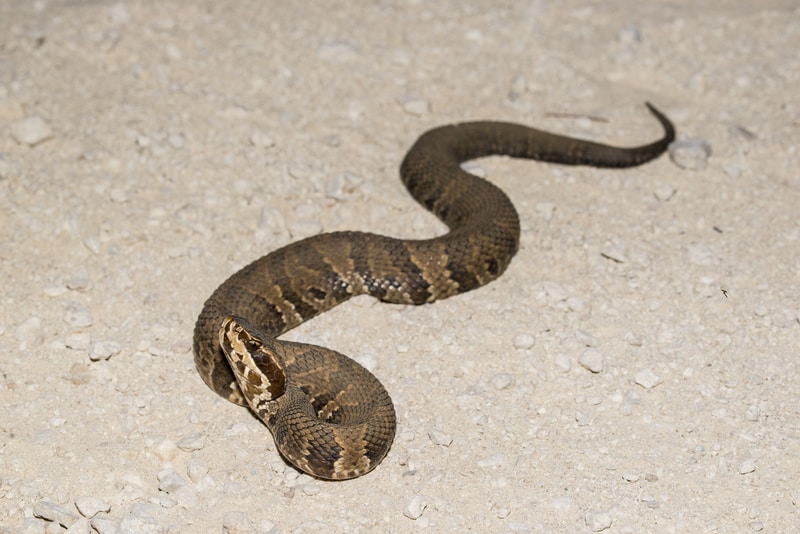
Florida Cottonmouth (Agkistrodon conanti)
Another name for the cottonmouth is water moccasin.
What Do Florida Cottonmouths Look Like?
| Size | *Average length: 30 to 48 inches (76 to 122 cm). *Larger individuals: May exceed 72 inches (183 cm). |
| Coloration | *Body: Dark brown to black with 10 to 17 dark bands. *Cheek: Black stripe on each cheek. *Older snakes may darken to the point where markings are obscure or absent. *Inside is pale pink to white, visible during their defensive open-mouthed pose (origin of the name “cottonmouth”). |
| Body Shape | *Stout, muscular snakes. |
| Behaviors | *Cottonmouths arc their heads upward and display an open-mouthed pose when agitated. This exposes the white interior of their mouth. This is a warning to back off or suffer the consequences. *Interestingly, they can hold their breath underwater for up to an hour while hunting for prey. |
| Distinctive Features | *Two dark bands run vertically on the tip of the snout (not present in Northern cottonmouths). *Pupils are cat-like and elliptical, appearing as narrow slits during the day. At night, pupils appear round. |
Where Do Florida Cottonmouths Live in Georgia?
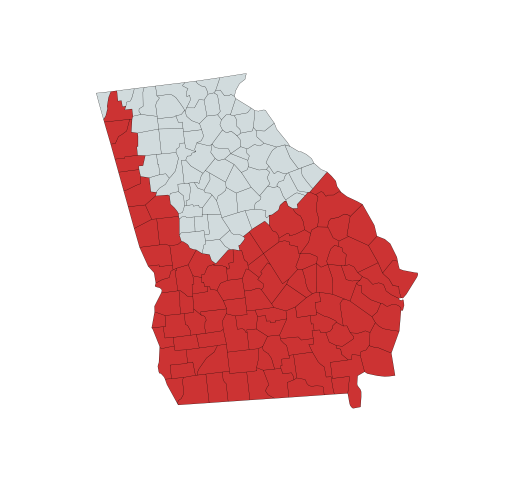
The range of the Florida cottonmouth in Georgia is mainly restricted to the Coastal Plain region. It also extends up the western side of the state.
These snakes spend most of their time near swamps, marshes, rivers, and lakes. But they are not entirely dependent on water. Sometimes, they are seen as far as one mile from any surface water. They can breathe underwater for up to an hour while hunting for prey.
How Dangerous Are Florida Cottonmouths?
Florida cottonmouth snakes have potent hemolytic venom. Hemolytic venom destroys red blood cells. The venom from these snakes has the potential to cause extensive necrosis. It is also more lethal than the venom of Northern Cottonmouths. The mortality rate is up to 17%.
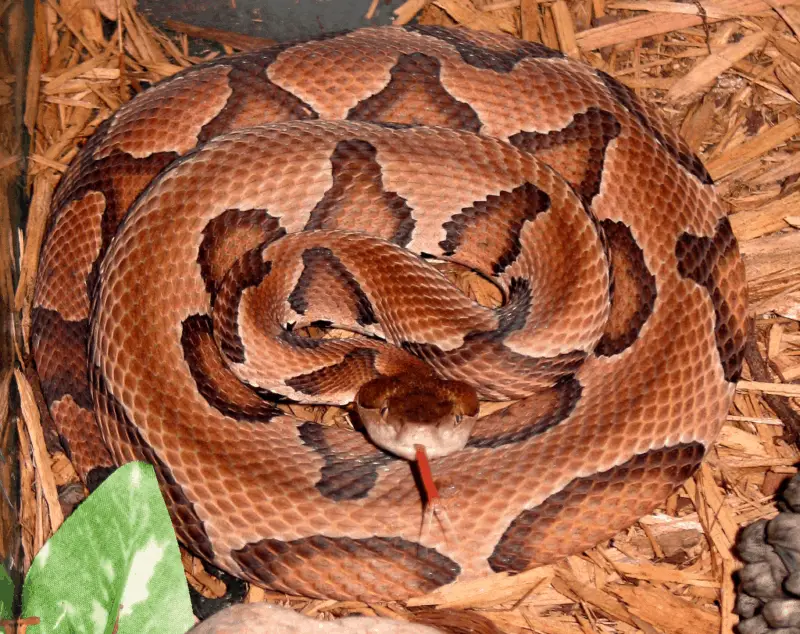
Eastern Copperhead (Agkistrodon contortrix)
The Eastern Copperhead is a pit viper native to the eastern United States.
What Do Eastern Copperheads Look Like?
| Size | *Adults range from 20 to 37 inches (50 to 95 cm) in length. |
| Coloration | *Reddish-tan to grayish-tan bodies. *Overlaid with dark brown, hourglass-shaped markings. *Heads are dark coppery brown, giving them the name “Copperhead.” |
| Body Shape | *Stout and heavy-bodied snakes. *As with all pitvipers, their heads are triangular and appear oversized in relation to their necks. |
Taxonomy of Georgia’s Eastern Copperhead Snakes
Copperhead snakes are found across Georgia and are now recognized as a single species: the Eastern Copperhead (Agkistrodon contortrix).
Where Do Eastern Copperheads Live in Georgia?
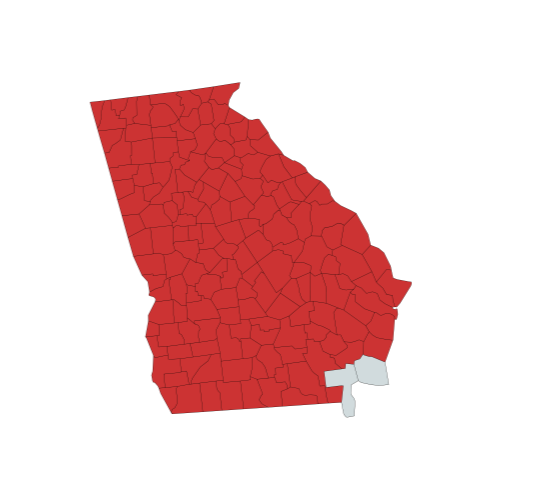
Copperheads are present across the majority of Georgia, except for the southeastern corner.
Eastern Copperhead Behavior
Copperheads are dangerous because they use camouflage as their number one defense mechanism. In other words, these snakes choose to lie perfectly still rather than flee most of the time. Their camouflage helps them blend in with leaf litter and other ground debris.
When they feel threatened, they occasionally mimic the tail vibration of a rattlesnake. But, in most cases, they choose to lie perfectly still.
Most copperhead bites on humans occur when the person steps on or near the snake.
What Do Copperheads Eat?
Copperhead snakes are opportunistic feeders. They eat insects, spiders, frogs, small rodents, birds, and other reptiles.
How Dangerous Are Copperheads?
A Copperhead can bite and inject venom from the time they are newly born. Like most pit vipers, they have hemotoxic venom.
Most copperhead bites are not life-threatening. On the other hand, any bite from this snake is a medical emergency and should be treated as such. Prompt medical attention increases the chance of a good outcome.
Copperhead bites can cause intense pain, shock, and swelling. Their bites also have the potential to cause blood in urine, tissue damage, and kidney failure.
An interesting study has found that Copperhead venom contains a protein called contortrostatin. Contortrostatin has been found to stop the growth of cancer cells in mice.
Rattlesnakes in Georgia
Rattlesnakes are pit vipers. See the description of pit vipers above.
Here’s a list of Georgia’s rattlesnake species.
- Eastern Diamondback Rattlesnake (Crotalus adamanteus)
- Dusky Pygmy Rattlesnake (Sistrurus miliarius barbouri)
- Timber Rattlesnake (Crotalus horridus)
What Georgia’s rattlesnakes have in common with most other rattlesnake species is their rattle.
- Most rattlesnakes have a rattle at the end of their tail, comprised of hollow, loosely interlocked keratinous scales.
- Normally, a rattlesnake adds a new segment to its rattle each time it sheds its skin.
- An agitated rattlesnake rapidly vibrates its tail, causing the segments of its rattle to vibrate together, creating a rattling or buzzing sound.
- Not all rattlesnakes rattle before they strike. Sometimes, they lose their rattles due to injury, and sometimes, they choose not to rattle.
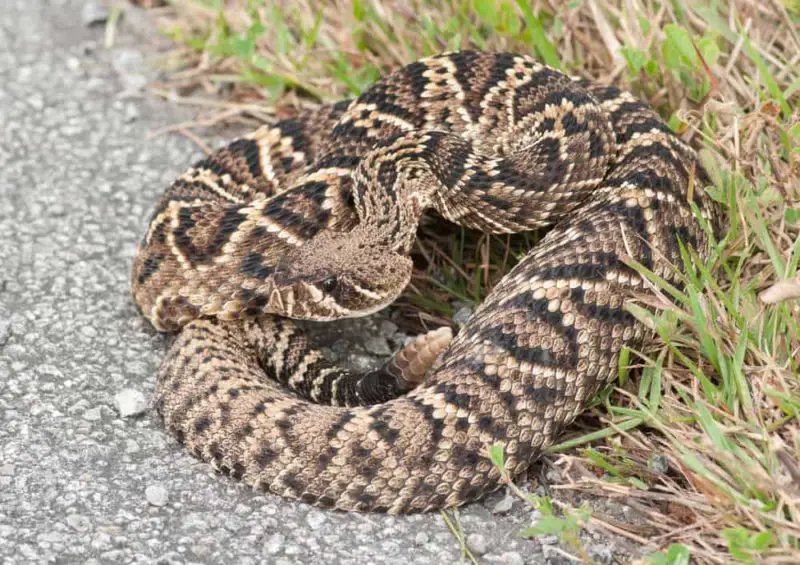
Eastern Diamondback Rattlesnake (Crotalus adamanteus)
The Eastern Diamondback rattlesnake is the largest venomous snake in the United States.
What Do Eastern Diamondback Rattlesnakes Look Like?
| Size | *Average length: 3 to 6 feet (0.91 to 1.83 m). *Record length: Up to 8 feet. *Average weight: 5 to 10 pounds (2.27 to 4.54 kg). |
| Coloration | *Base colors: Brownish-yellow, brownish-gray, or olive green. *Back: Brownish-black diamond-shaped pattern lined with cream-colored scales. *Tail: Diamond blotches transition into crossbands near the tail. *Belly: Cream-colored with dark mottling along the sides. |
| Distinctive Markings | *The black band is outlined with white bands on either side. *A black band runs from behind each eye down towards the mouth. |
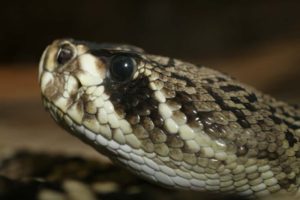
Where Do Eastern Diamondbacks Live in Georgia?
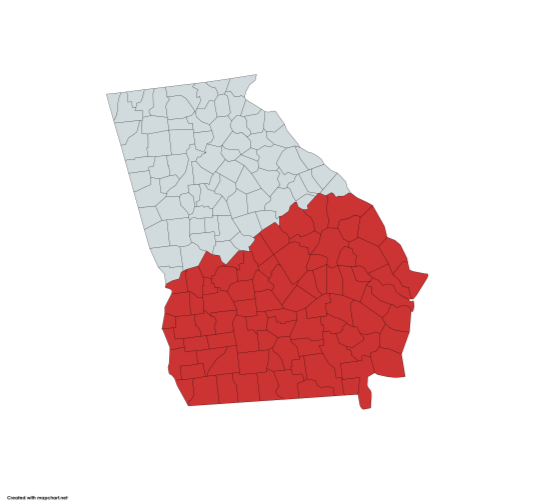
Eastern diamondbacks are located in Georgia’s Coastal Plain, south of the Fall Line.
They prefer coastal forests, scrublands, and pine and wiregrass flatwoods. They can be found in moist areas such as wet prairies, savannas, and around wetland borders. These snakes are proficient swimmers. It’s not uncommon for them to swim between barrier reefs and along swamp edges.
Eastern Diamondback Rattlesnake Behavior
Eastern Diamondbacks shelter in gopher, tortoise, and armadillo burrows. They emerge early in the morning or afternoon to bask in the sun. Occasionally, these snakes climb into bushes and trees, hunting for prey. Some have been spotted as high as 33 feet off the ground.
How Dangerous Are Eastern Diamondback Rattlesnakes?
Eastern Diamondback Rattlesnakes have potent hemotoxic venom. In fact, they kill more people than any other venomous snake in the United States.
Eastern Diamondback bites cause severe pain, edema, headache, nausea, dizziness, and convulsions. Their hemotoxic venom impairs blood coagulation. This may lead to severe internal bleeding, which may lead to kidney damage.
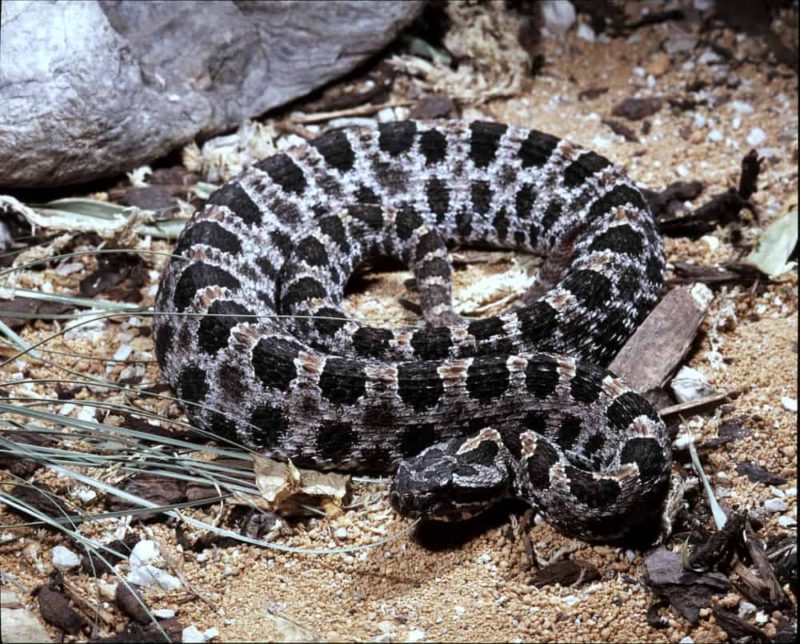
Dusky Pygmy Rattlesnake (Sistrurus miliarius barbouri)
The Dusky Pygmy Rattlesnake is a small, slender-tailed snake with a tiny rattle.
What Do Dusky Pygmy Rattlesnake Look Like?
| Size | *Small, slender-tailed snake with a tiny rattle. *Length: 14 to 30 inches (36 to 76 cm). *Average length: 21.1 inches (54 cm). |
| Coloration and Markings | *Body: Dark gray with dark-colored blotches along the top and sides. *Stripe: Rust-colored vertical stripe on the back (may be absent in some individuals). *Belly: Cream-colored, often mottled. *Face: Distinct dark stripe from the corner of the mouth to the eye. |
| Rattle and Sound | *A tiny rattle produces a faint, grasshopper-like buzz. *Sound can only be heard from a few feet away. |
Where Do Dusky Pygmy Rattlesnake Live in Georgia?
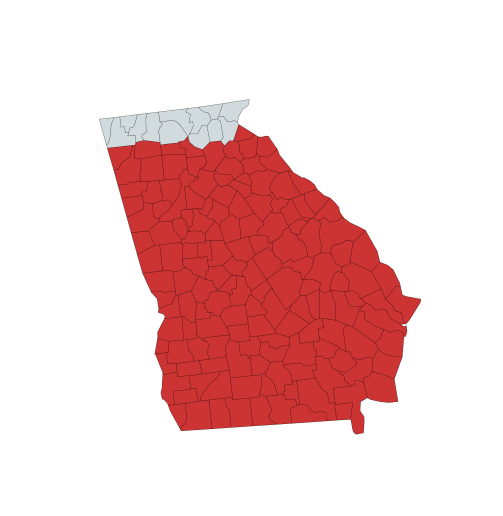
These snakes prefer sandy pinelands and scrub regions near bodies of water. Pygmy rattlesnakes are rarely found in arid habitats.
The Dusky Pygmy Rattlesnake is found in the southern 7/8 of Georgia. They are found in the sandhills, mixed forests, and floodplains. They are also located near marshes and lakes.
These snakes also have other common names. A couple of them are Barbour’s Pygmy Rattlesnakes and Florida Ground Rattlesnakes.
How Dangerous Are Dusky Pygmy Rattlesnakes?
Dusky Pygmy rattlers have cytotoxic venom. By definition, cytotoxic venom destroys the body’s cells. It contains digestive enzymes that disrupt blood flow and prevent blood from clotting. Luckily, these snakes produce a small venom yield. Dusky Pygmy Rattlesnake bites are painful. But there has never been a human fatality caused by one. But any pigmy rattlesnake bite victim should still receive prompt medical attention.
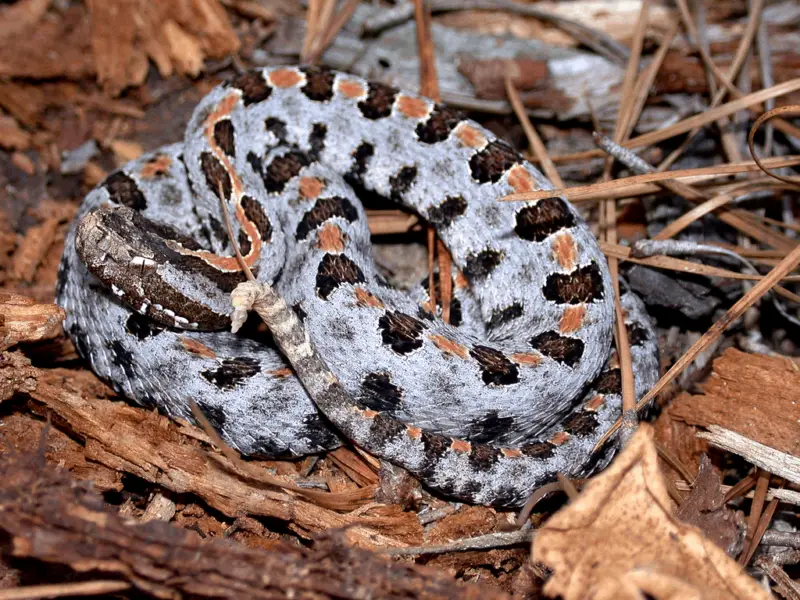
Carolina Pygmy Rattlesnake (Sistrurus miliarius miliarius)
The Carolina Pygmy Rattlesnake is a small, slender-tailed snake with a tiny rattle.
What Do Carolina Pygmy Rattlesnake Look Like?
| Size | *Small, slender-tailed snake with a tiny rattle. *Length: 16 to 25 inches (41 to 64 cm). *Average length: 21.1 inches (54 cm). |
| Coloration and Markings | *Body: Light gray to reddish above, with dark-colored blotches along the top and sides. *Stripe: Rust-colored vertical stripe on the back (may be absent in some individuals). *Belly: Cream-colored, often mottled. *Face: Distinct dark stripe from the corner of the mouth to the eye. |
| Rattle and Sound | *A tiny rattle produces a faint, grasshopper-like buzz. *Sound can only be heard from a few feet away. |
Where Do Carolina Pygmy Rattlesnakes Live in Georgia?

Carolina Pygmy Rattlesnakes prefer sandy pinelands and scrub regions near bodies of water. Pygmy rattlesnakes are rarely found in arid habitats.
The Carolina Pygmy Rattlesnake is found in the southern 7/8 of Georgia. They are found in the sandhills, mixed forests, and floodplains. They are also located near marshes and lakes. In southern Georgia, they are also seen in saw palmetto thickets.
This snake has some other common names. They are Pygmy Rattlesnake, Ground Rattlesnake, and Hog-nosed rattlesnake.
How Dangerous Are Carolina Pygmy Rattlesnakes?
Carolina Pygmy rattlesnakes have cytotoxic venom. By definition, cytotoxic venom destroys the body’s cells. Luckily, these snakes produce a small venom yield. A Pygmy Rattlesnake bite is unlikely to be fatal. However, any bite victim should still receive prompt medical attention.
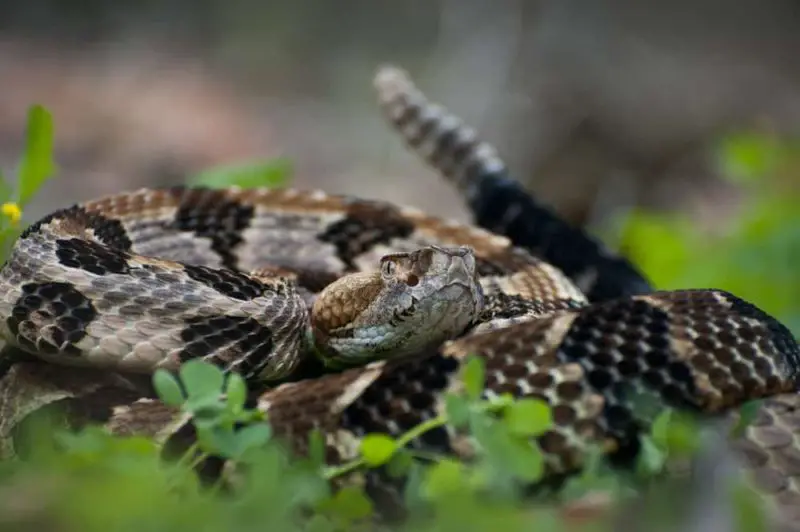
Timber Rattlesnake (Crotalus horridus)
Timber Rattler and Canebrake Rattlesnake are both common names for the Timber Rattlesnake. Generally, in higher-elevation habitats, they are called Timber Rattlesnakes. On the coastal plain, though, they’re called Canebrake Rattlesnakes.
What Do Timber Rattlesnakes Look Like?
| Size | *Average length: 36 to 60 inches (0.91 to 1.52 m). *Rare cases reported: Up to 7 feet (2.13 m). |
| Coloration | *General base color: Yellowish-brown to grey-brown. *Chevron pattern: Dark brown to black chevrons on their back and sides against a lighter base color. *Back stripe: Rusty to reddish stripe running down their back. *Tail color: Dark brown or black. |
| Melanistic Variation | *Some timber rattlesnakes exhibit a dark, melanistic color morph. *These snakes can appear almost entirely black. *The tail is darker than the rest of the body in this morph. |
| Behaviors | *These snakes are excellent climbers. In fact, timber rattlers have been found in trees at heights of more than 80 feet. *The experts have proven that timber rattlesnakes help control Lyme disease. This is because as they consume rodents, they’re also consuming ticks. A timber rattler will consume 2,500 to 4,500 ticks per year, depending on the location. |
Where Do Timber Rattlesnakes Live in Georgia?

Timber rattlesnakes live throughout Georgia except for locations in the far southwestern corner.
What Do Timber Rattlesnakes Eat?
Timber rattlers prey on small mammals such as mice, rats, squirrels, and chipmunks. They also eat small birds, other reptiles, and amphibians.
These snakes are excellent climbers. In fact, timber rattlers have been found in trees at heights of more than 80 feet.
The experts have proven that timber rattlesnakes help control Lyme disease. This is because as they consume rodents, they’re also consuming ticks. A timber rattler will consume 2,500 to 4,500 ticks per year, depending on the location.
How Dangerous Are Timber Rattlesnakes?
Timber Rattlesnakes are among the most dangerous snakes in North America. This is due to their long fangs and high venom yield. 1% to 10% of untreated Timber Rattlesnake bites result in a fatality.
Fortunately, 40% to 60% of the time, they produce dry bites. In other words, although their fangs penetrate the body, they do not inject any venom.
These snakes produce hemotoxic venom. Timber Rattlesnake bites sometimes cause serious complications. These include shock, seizures, coma, internal bleeding, and deep tissue damage.
Coral Snakes
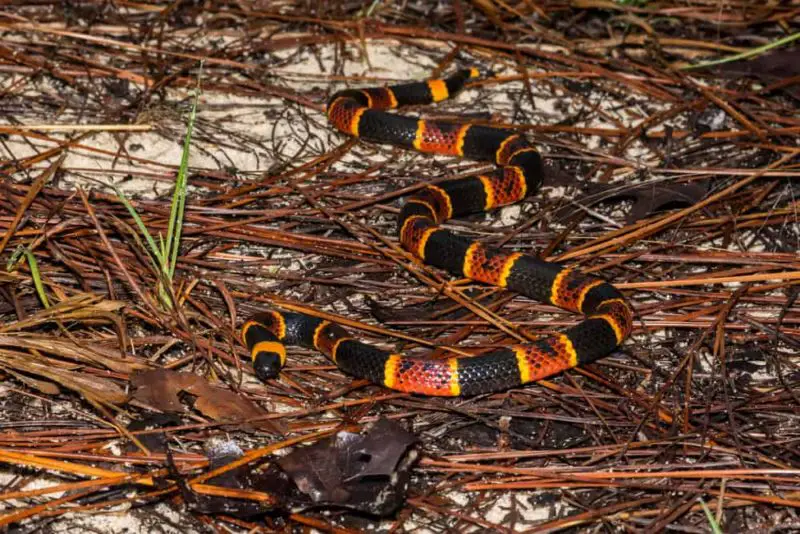
Eastern Coral Snake (Harlequin Coral)
The Eastern Coral Snake is the only venomous snake in Florida that is not a pit viper. Instead, they belong to the Elapidae family, along with Cobras and Mambas.
What Do Eastern Coral Snakes Look Like?
| Size | *Eastern Coral Snakes can grow up to 4 feet (122 cm), but most are around 2 feet (61 cm). *Sexually dimorphic: Males are slightly smaller than females. |
| Coloration | *Brightly colored, highly venomous snake. *Bands of black, light yellow, and red. *Yellow bands separate the red and black bands. |
| Physical Features | *Rounded heads and noses, with tails that resemble the head. *This similarity can make distinguishing the head from the tail hard |
Where Do Eastern Coral Snakes Live in Georgia?
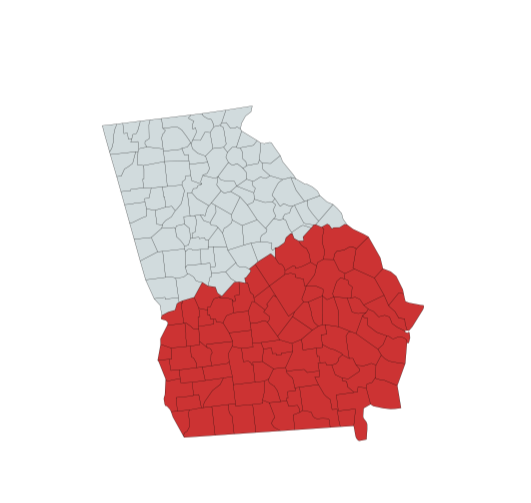
In Georgia, the Eastern Coral snake primarily lives in the state’s southeastern part. This is on the Coastal Plain below the Fall Line.
The places they live in range from dry, open, bushy areas to hardwood forests and pine flatwoods.
Batesian Mimicry Of Coral Snakes
Batesian mimicry is a biological term. It describes how a harmless species protects itself by resembling a dangerous one. For example, scarlet king snakes and eastern milk snakes are non-venomous snakes. However, their color patterns closely resemble the venomous coral snake. The difference is that a coral snake’s red and yellow bands touch. On the other hand, the nonvenomous species’ color patterns are red, black, and yellow. Also, a coral snake’s head is blunt and entirely black, even behind its eyes, while a Kingsnake’s head is red.
This rhyme helps people distinguish between a nonvenomous species and a coral snake. “Red touch yellow can kill a fellow; Red touches black, a friend of Jack.”
The rhyme is mostly accurate in the United States. However, coral snakes from areas south of the U. S. do not always follow the black-yellow-red pattern. This is also true in Central America, South America, and the Caribbean.
Finally, there are rare coral snakes that do not follow the usual color pattern in the United States. Pink, cream-colored, light blue and completely black coral snakes exist in the wild.
How Dangerous are Coral Snakes?
Coral snakes are highly venomous snakes. In fact, herpetologists regard them as the most venomous snake in the United States. Fortunately, they almost never bite.
A coral snake’s venom is a neurotoxin and is the second strongest of any snake. The experts consider coral snakes to be less dangerous than rattlesnakes, though. Their smaller mouths and short fangs produce less venom. Thus, they have a less effective venom delivery system.
People should take coral snake bites seriously, though. Before we had antivenom, the death rate after coral snake envenomation was around 10%.
Potential effects of coral snake envenomation include,
- muscle weakness
- difficulty speaking
- difficulty swallowing
- difficulty breathing
- Inability to move eyelids
- blurred vision
- twitching of the tongue
- paralysis
- respiratory arrest
One reported death has been caused by an Eastern Coral Snake bite in the last 40 years.
Georgia’s Venomous Snakes in Winter: Insights into Brumation
During winter, Georgia’s snakes, like all reptiles, enter a dormant state called brumation—a hibernation-like period. Because snakes are ectothermic (cold-blooded) and cannot regulate their body temperature internally, they slow their metabolism and become inactive during the colder months.
Brumation Habits
- Solo vs. Communal Brumation: Some snakes brumate alone, while others gather in communal dens. For example, Eastern Copperheads and Timber Rattlesnakes often share dens, which may house up to 60 snakes.
- Mixed-Species Dens: Interestingly, it’s not uncommon to find non-venomous snakes, such as Black Rat Snakes, sheltering alongside venomous snakes.
Regional Variations
- Snakes may only seek shelter in warmer areas, such as southern and northwestern Georgia, on the coldest days.
Where Snakes Spend Winter
Snakes seek out protected spots to brumate, such as:
- Rock crevices
- Hollow logs
- Fissures on rocky hillsides
They often choose south-facing slopes because these areas receive more sunlight, providing additional warmth during winter.
This natural adaptation allows Georgia’s venomous snakes to survive the winter and re-emerge when temperatures rise.
Avoiding Snake Bite
Snakes, including venomous ones, commonly rely on camouflage to hide from potential threats. They often remain perfectly still to avoid detection. If you’re walking in the woods and unknowingly get too close, a snake might not move, hoping you’ll pass by. Many bites happen when someone accidentally steps on or close to the snake. To stay safe in snake habitats, always watch where you step and where you place your hands.
Another common cause of snake bite is attempts to capture or kill a snake. Remember, venomous snakes can strike instantly, delivering a potentially life-threatening bite. The safest approach is to keep a safe distance and leave them alone.
Dressing for Snake Country
- High-top leather boots and long pants are both wise ideas.
- Also, wear loose-fitting denim. If there’s a gap before the snake’s fangs touch your skin, your chances of being envenomated are lower.
- In the absence of high-top leather boots, some people wear snake gaiters
Symptoms of Venomous Snake Bites
Some of the symptoms you may experience when a venomous snake bites you include:
- Discoloration in the area of the bite.
- Swelling in the area of the bite.
- Loss of muscle coordination.
- Tingling sensation in the area of the bite.
- Feeling nauseous.
- Having a faster heartbeat or rapid pulse.
What Should You Do if You Are Bitten?
If you or someone you are with has suffered a venomous snakebite, time is of the essence. Because the sooner a victim receives antivenom, the less chance the venom in their body has to cause harm. In other words, it is important to seek immediate medical treatment.
Do not attempt to kill the snake for identification purposes. This gives the snake a chance to bite you again. Also, consider that severed snakeheads can still bite and envenomate and often do. If you have a phone, take a picture of the offending reptile. Otherwise, get started on your way to the nearest hospital.
First Aid for Snake Bite Victims
- Remain calm and limit your movements. Do not run. If you must hike back to a vehicle, do it calmly and deliberately. Put as little stress on your heart as possible.
- Keep the area of the snake bite below the heart level and never above the heart level. Keeping the bite below the heart level will reduce the venom’s flow. However, holding the bite above your heart level will increase the venom’s flow.
- Remove all constricting items such as bracelets, watches, or rings before swelling occurs.
- Remember that using a cold compress on a venomous snake bite is not advisable. The cold may cause the local blood vessels to constrict and spread the venom faster.
- You can wash the affected area like any other wound with soap and water.
- You may cover the bite area with a moist dressing to reduce the swelling.
- Get medical attention as soon as possible. Call the hospital to tell them a venomous snake has bitten you. So they can have antivenom ready to give you when you arrive.
- A person whom a venomous snake has bitten may go into shock. If this happens, lay them flat and cover them with a blanket.
Conclusion
There are seven venomous snake species in Georgia. Each one plays a crucial role in the state’s ecosystems. From the copperhead and cottonmouth to the four species of rattlesnake and the eastern coral snake, these reptiles exhibit unique adaptations for survival and hunting.
Each one of these snakes is potentially dangerous. However, understanding their habitats and behaviors and identifying characteristics is key to safely coexisting with them.
By respecting these snakes, exercising caution in snake-prone areas, and avoiding unnecessary interactions, residents and visitors can greatly reduce the risk of venomous snake bites.
You Might Also Like
Bears in Georgia – Krebs Creek
Wild Cats in Georgia – Krebs Creek
3 Georgia Scorpions and How to Identify Them – Krebs Creek
Recent Posts
The only venomous snakes in Washington State are Northern Pacific Rattlesnakes. The Northern Pacific Rattlesnake (Crotalus oreganus oreganus) is a sub-species of the Western Rattlesnake. Anyone...
Skunks are not classified as true hibernators. But they go into a state of torpor when the weather gets cold. Skunks are light sleep hibernators, along with opossums, bears, and raccoons. ...
